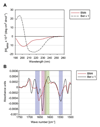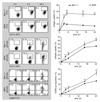Reshaping the Bet v 1 fold modulates T(H) polarization
- PMID: 21420160
- PMCID: PMC5689381
- DOI: 10.1016/j.jaci.2011.01.064
Reshaping the Bet v 1 fold modulates T(H) polarization
Abstract
Background: Several alternative mechanisms have been proposed to explain why some proteins are able to induce a T(H)2-biased and IgE-mediated immune response. These include specific interactions with receptors of the innate immune system, proteolytic activities, allergen-associated carbohydrate structures, and intrinsic structural determinants.
Objectives: Available data suggest that a fold-dependent allergy-promoting mechanism could be a driving force for the T(H)2-polarization activity of Bet v 1, the major birch pollen allergen.
Methods: Computer-aided sequence and fold analysis of the Bet v 1 family identified a short stretch susceptible for mutations inducing an altered fold of the entire molecule. With this knowledge, 7 consecutive amino acids of Bet v 1 were replaced with the homologous Mal d 1 sequence, creating the derivative BM4.
Results: The minimal changes of the sequence led to a loss of the Bet v 1-like fold and influenced the immunologic behavior. Compared to wild-type Bet v 1, BM4 induced elevated T-cell proliferation of human PBMCs. In the mouse model, immunization with Bet v 1 absorbed to aluminum hydroxide triggered strong T(H)2 polarization, whereas BM4 immunization additionally recruited T(H)1 cells. Furthermore, the fold variant BM4 showed enhanced uptake by dendritic cells and a decreased susceptibility to endo-/lysosomal proteolysis.
Conclusion: Modifications in the 3-dimensional structure of Bet v 1.0101 resulted in a change of its immunologic properties. We observed that the fold alteration led to a modified crosstalk with dendritic cells and a shift of the immune response polarization toward a mixed T(H)1/T(H)2 cytokine production.
Copyright © 2011 American Academy of Allergy, Asthma & Immunology. Published by Mosby, Inc. All rights reserved.
Conflict of interest statement
Disclosure of potential conflict of interest: M. Hauser receives research support from CK-Care AG, Switzerland. M. Himly receives research support from the Austrian Science Fund, Biomay AG, and the Austrian Research Promotion Agency. R. van Ree is a consultant for and receives research support from HAL Allergy BV. J. Thalhamer has consultant arrangements with Biomay AG and receives research support from Biomay AG, Christian Doppler Forschungsgesellschaft, and the Austrian Science Fund. B. Bohle receives research support from the Austrian Science Fund and Christian Doppler Forschungsgesellschaft. F. Ferreira receives research support from Biomay AG, the Austrian Science Fund, the Christian Doppler Research Association, and the European Union and has provided consultation for the AllergenOnline Database. The rest of the authors have declared that they have no conflict of interest.
Figures






Similar articles
-
In vivo Induction of Functional Inhibitory IgG Antibodies by a Hypoallergenic Bet v 1 Variant.Front Immunol. 2020 Sep 3;11:2118. doi: 10.3389/fimmu.2020.02118. eCollection 2020. Front Immunol. 2020. PMID: 33013894 Free PMC article.
-
A nonallergenic birch pollen allergy vaccine consisting of hepatitis PreS-fused Bet v 1 peptides focuses blocking IgG toward IgE epitopes and shifts immune responses to a tolerogenic and Th1 phenotype.J Immunol. 2013 Apr 1;190(7):3068-78. doi: 10.4049/jimmunol.1202441. Epub 2013 Feb 25. J Immunol. 2013. PMID: 23440415 Free PMC article.
-
A hypoallergenic variant of the major birch pollen allergen shows distinct characteristics in antigen processing and T-cell activation.Allergy. 2012 Nov;67(11):1375-82. doi: 10.1111/all.12016. Epub 2012 Sep 13. Allergy. 2012. PMID: 22973879
-
Humoral immune responses to recombinant tree pollen allergens (Bet v I and Bet v II) in mice: construction of a live oral allergy vaccine.Int Arch Allergy Immunol. 1995 May-Jun;107(1-3):290-4. doi: 10.1159/000237005. Int Arch Allergy Immunol. 1995. PMID: 7613152 Review.
-
Innate responses to pollen allergens.Curr Opin Allergy Clin Immunol. 2015 Feb;15(1):79-88. doi: 10.1097/ACI.0000000000000136. Curr Opin Allergy Clin Immunol. 2015. PMID: 25546327 Free PMC article. Review.
Cited by
-
In vivo Induction of Functional Inhibitory IgG Antibodies by a Hypoallergenic Bet v 1 Variant.Front Immunol. 2020 Sep 3;11:2118. doi: 10.3389/fimmu.2020.02118. eCollection 2020. Front Immunol. 2020. PMID: 33013894 Free PMC article.
-
Enlarging the toolbox for allergen epitope definition with an allergen-type model protein.PLoS One. 2014 Oct 30;9(10):e111691. doi: 10.1371/journal.pone.0111691. eCollection 2014. PLoS One. 2014. PMID: 25356997 Free PMC article.
-
Contributions and Future Directions for Structural Biology in the Study of Allergens.Int Arch Allergy Immunol. 2017;174(2):57-66. doi: 10.1159/000481078. Epub 2017 Oct 10. Int Arch Allergy Immunol. 2017. PMID: 28992615 Free PMC article. Review.
-
Tackling Bet v 1 and associated food allergies with a single hybrid protein.J Allergy Clin Immunol. 2017 Aug;140(2):525-533.e10. doi: 10.1016/j.jaci.2016.09.055. Epub 2016 Dec 7. J Allergy Clin Immunol. 2017. PMID: 27939703 Free PMC article.
-
Does clinical outcome of birch pollen immunotherapy relate to induction of blocking antibodies preventing IgE from allergen binding? A pilot study monitoring responses during first year of AIT.Clin Transl Allergy. 2018 Oct 8;8:39. doi: 10.1186/s13601-018-0226-7. eCollection 2018. Clin Transl Allergy. 2018. PMID: 30338052 Free PMC article.
References
-
- Mothes N, Horak F, Valenta R. Transition from a botanical to a molecular classification in tree pollen allergy: implications for diagnosis and therapy. Int Arch Allergy Immunol. 2004;135:357–73. - PubMed
-
- Wagner S, Radauer C, Bublin M, Hoffmann-Sommergruber K, Kopp T, Greisenegger EK, et al. Naturally occurring hypoallergenic Bet v 1 isoforms fail to induce IgE responses in individuals with birch pollen allergy. J Allergy Clin Immunol. 2008;121:246–52. - PubMed
-
- Smole U, Wagner S, Balazs N, Radauer C, Bublin M, Allmaier G, et al. Bet v 1 and its homologous food allergen Api g 1 stimulate dendritic cells from birch pollen-allergic individuals to induce different Th-cell polarization. Allergy. 2010;65:1388–96. - PubMed
Publication types
MeSH terms
Substances
Grants and funding
LinkOut - more resources
Full Text Sources
Other Literature Sources
Research Materials

